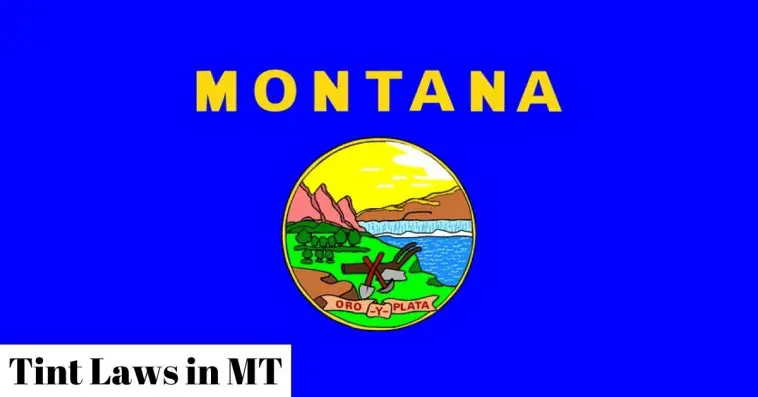Enacted in 1991, Montana window tint laws were later amended in 2007. If you want to know more about tinting in this Mountain West region, you’ve come to the right place.
This is a comprehensive list of all the practical information about a car’s window tint, including whether it is legal, how dark the tint can be, and how much it costs.
With tinting, you can apply a transparent film sheet to the glass of the vehicle. This provides a plethora of benefits, such as reducing the dangerous UV rays.
But, most importantly, it decreases the damage done to your belongings when you leave them inside the car.
Tinting is meant to reflect glare, heat, and 99% of UV rays. Whereas with strong tint reflection, you can reduce the heat by around 80%. That’s more than enough to boost insulation, keep the vehicle cool, and give you a sense of privacy.
Here, you will take a closer look at the tint rules and regulations in this state that could prove useful.
TABLE OF CONTENTS
Are You Allowed To Have Tinted Windshield And Windows In Montana?
Tinted windows are absolutely allowed in Montana. But, the percentage of Visible Light Transmission (VLT) on your car window is specific and limited. It is also unique for SUVs, vans, and sedan cars. Each U.S. state has different allowable tint limits.
According to the laws, the amount of film used and the allowed light that passes through is predefined. As mentioned, it is different for multi-purpose vehicles (MPVs) and passenger vehicles.
People can’t just tint their windows as much as they want to. They need to stick to the guidelines and limitations. The good thing is, following these regulations across the state is relatively easy. If you have the right information, of course.
What Is The Darkest Tint You Can Legally Get In MT?
Darkness is measured by the VLT percentage. In Montana tint laws, the percentage refers to the amount of visible light allowed through the film.
The level of tint varies based on the type of vehicle you own. The tinting limits are more rigorous when it comes to passenger vehicles, compared to MPVs. The legal tint limit in this state is 24%. It must let over 24% of light in from the front side windows.
Is 20 Tint Illegal In MT?
Windshields mustn’t have amber, red, or yellow sunscreening material that’s above the AS-1 line. And it may not be transparent below the AS-1 line.
When it comes to reflectivity, no more than 35% reflective tint is allowed in Montana. For rear windows or side windows, glass tinting that decreases light transmission below 32% or boosts reflectance well over 20% is illegal.
Can You Get Pulled Over For Tinted Windows In Montana?
Of course. If you violate the tint laws you can get pulled over. Although you might not have to get pulled over every time you drive by law enforcement, the odds get bigger each time you do pass.
In most cases, a police officer pulls over people who drive over the speed limit. If they detect anything else, such as extremely dark tint, then they will probably point out the legal limits.
How Much Is A Tint Ticket In MT?
It depends. The cost is determined by how dark the tint is, for instance, 50% over the legal limit. And whether this is your first time getting a ticket. Since tint tickets are under the minor traffic laws, you may have to pay $25 as a first warning.
For the first ticket, the cost is usually $100. The second time, however, you may have to pay more than $200. If you take off the tint the moment the police officer pulls you over, you might have to pay additional charges. These fees will add up.
Window Tint Darkness In Montana
Just like any other state in the U.S., Montana has its own tinting limits and guidelines. As pointed out earlier, it is important that you stick to these limits when you want to darken the windows.
Here, you can take a look at the specific guidelines associated with tinting. Particularly for MPV and passenger vehicles according to the laws of the state.
For Passenger Vehicle
- Windshield: You are eligible for using non-reflective tint that’s over the AS-1 line of the manufacturer.
- Front Side Windows: The tint has to let over 24% of the light in.
- Back Side Windows: The tint has to let over 14% of the light in.
- Rear Window: The tint has to let over 14% of the light in.
For MPV (Multi-Purpose Vehicle)
- Windshield: You are eligible for using non-reflective tint that’s over the AS-1 line of the manufacturer.
- Front Side Windows: The tint has to let over 24% of the light in.
- Back Side Windows: You can use any level of darkness.
- Rear Window: You can use any level of darkness.
Window Tint Reflection In Montana
Various states across the U.S. are allowing car owners to own reflective surfaces on their vehicles. This is to decrease the amount of heat and light that enters.
However, tint reflection also has a limit, and Montana is no exception. To learn more, check out the reflection limits below:
For Passenger Vehicle
- Front Side Window: Mustn’t exceed 35% reflection.
- Back Side Window: Mustn’t exceed 35% reflection.
For MPV (Multi-Purpose Vehicle)
- Front Side Window: Mustn’t exceed 35% reflection.
- Back Side Window: Mustn’t exceed 35% reflection.
How Do You Get A Medical Exemption For Window Tint In Montana?
Local law enforcement can grant a window tinting waiver to a licensed physician with a properly signed affidavit.
People who also suffer from eye conditions, like light-sensitive porphyria, can get a note of exemption to apply darker tints. But, you must carry your certificate at all times to avoid getting fined.
Conclusion
That’s it! Now you know the ins and outs of the window tint laws in Montana. Now that you know exactly how they look, you will have an easier time avoiding trouble. Make sure to stick to the regulations, and you never have to worry about the tints ever again.
Also, don’t forget to do your own research if you live in a different state. So, try to stay up to date as much as possible.




